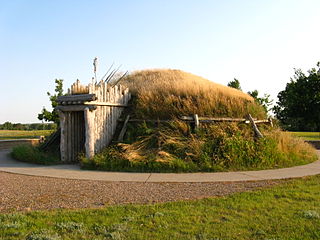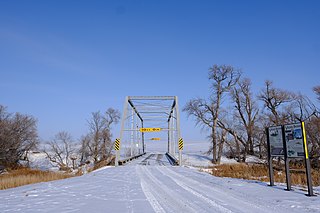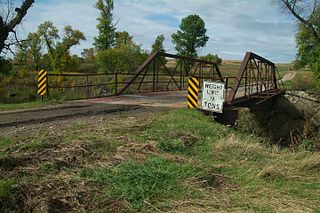
The Knife River is a tributary of the Missouri River, approximately 120 mi (193 km) long, in North Dakota in the United States.

The Knife River Indian Villages National Historic Site, which was established in 1974, preserves the historic and archaeological remnants of bands of Hidatsa, Northern Plains Indians, in North Dakota. This area was a major trading and agricultural area. Three villages were known to occupy the Knife area. In general, these three villages are known as Hidatsa villages. Broken down, the individual villages are Awatixa Xi'e, Awatixa and Big Hidatsa village. Awatixa Xi'e is believed to be the oldest village of the three. The Big Hidatsa village was established around 1600.

The Sorlie Memorial Bridge, also known as the Red River Bridge, was constructed in 1929 by the Minneapolis Bridge Company to connect the cities of Grand Forks, North Dakota and East Grand Forks, Minnesota. It was placed on the National Register of Historic Places in 1999.

The Big Hidatsa site, occupied between ca. 1740 and 1850, is an earthlodge located in the 1,758 acre Knife River Indian Villages National Historic Site in North Dakota, United States. This National Historic Site was established in 1974 “to focus on the cultures and lifestyles of the Plains Indians”.

The Ost Valle Bridge is a bridge near Thompson, North Dakota that was listed on the National Register of Historic Places in 1997. It crosses an unnamed tributary of the Red River, about one mile west of the Red River itself. It is "one of the two oldest documented bridges in Grand Forks County that were built by long-term county bridge builder, the Jardine & Anderson".
The Goose River Bridge was a Pratt through truss bridge over the Goose River near Hillsboro, North Dakota that was built in 1893. It was listed on the National Register of Historic Places in 1997.

The Viking Bridge, also known as Goose River Bridge, near Portland, North Dakota, was built in 1885 over the Goose River. It was listed on the National Register of Historic Places in 1997.
The Elliott Bridge, in North Dakota, United States, also known as Souris River Bridge, was built by Fargo Bridge & Iron Co. in 1902. The bridge "was designed to replace a county-owned ferry boat that had been operating across the Souris River at 'the Elliott Place.'" It was listed on the National Register of Historic Places in 1997. It is owned and maintained by McHenry County.
The Grace City Bridge near Grace City, North Dakota, also known as the James River Bridge, is a Pratt through truss structure that was built in 1925 over the James River. It was listed on the National Register of Historic Places in 1997.
The Nesheim Bridge near McVille, North Dakota is a Pratt through truss structure that was built in 1904 to cross the Sheyenne River. It was listed on the National Register of Historic Places in 1997.
The New Rockford Bridge near New Rockford, North Dakota is a Warren truss bridge structure that was built in 1904 over the James River. It was listed on the National Register of Historic Places in 1997.

The Norway Bridge near Mayville, North Dakota is a Pratt pony truss structure that was built in 1912 over the Goose River. It was listed on the National Register of Historic Places in 1997.
The West Antelope Bridge near Flora, North Dakota is a pin-connected Pratt pony truss structure that was built in 1907. It was listed on the National Register of Historic Places in 1997.

The Westgaard Bridge, also known as Souris River Bridge, near Voltaire, North Dakota is a Pratt pony truss through structure that was built in 1902 to cross the Souris River. It was listed on the National Register of Historic Places in 1997.

The Liberty Memorial Bridge, across the Missouri River connecting the "twin cities" of Bismarck and Mandan, North Dakota, also known as Missouri River Bridge, was a Warren-Turner through truss structure that was built in 1920. It was listed on the National Register of Historic Places in 1997. It was replaced by a new bridge in 2008 and removed from the National Register in 2009.
The Porter Elliott Bridge, also known as Goose River Bridge, near Hillsboro, North Dakota is a Warren through truss structure that was built in 1902 over the Goose River. It was previously listed on the National Register of Historic Places, but was removed in 2009.
The Portland Park Bridge, also known as South Branch Goose River Bridge, near Portland, North Dakota is a Pratt through truss structure that was built in 1919 over the south branch of the Goose River. It was listed on the National Register of Historic Places. It was removed from the National Register in 2004.
The Colton's Crossing Bridge, in Ransom County, North Dakota near Lisbon, North Dakota, also known as Sheyenne River Bridge, was built in 1907. It was listed on the National Register of Historic Places (NRHP) in 1997.

The Lynch Quarry site, also known as the Lynch Knife River Flint Quarry, and designated by the Smithsonian trinomial 32DU526, is a historic pre-Columbian flint quarry located near Dunn Center, North Dakota, United States. The site was a major source of flint found at archaeological sites across North America, and it has been estimated that the material was mined there from 11,000 B.C. to A.D. 1600. The site was designated a National Historic Landmark in 2011.













